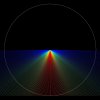That's not the issue.. I'm taking about the specification for a grow fixture.
For example your spec on one of your fixtures is PPFD 887 umol/sec/m2 in a 4X4 area
I guess you ARE on the same boat. You do not specify the distance. Is the 887µmol measured with the fixture at a specific height?
Do your fixtures magically put out the same PPFD at 24" as they do at 18"???
Whereas Heliospectra specifies a height of 18" in their PPFD spec.
Fluence says:
If you want to find out the true light intensity of a lamp over a designated growing area (e.g. 4’ x 4’), it is important that the average of several PPFD measurements at a defined height are taken. Lighting companies that only publish the PPFD at the center point of a coverage area grossly overestimate the true light intensity of a fixture. A single measurement does not tell you much, since horticulture lights are generally brightest in the center, with light levels decreasing as measurements are taken towards the edges of the coverage area. (Caveat Emptor: Lighting manufacturers can easily manipulate PPFD data. To ensure you are getting actual PPFD values over a defined growing area, the following needs to be published by the manufacturer: measurement distance from light source (vertical and horizontal), number of measurements included in the average, and the min/max ratio). Fluence always publishes the average PPFD over a defined growing area at a recommended mounting height for all of our lighting systems.


